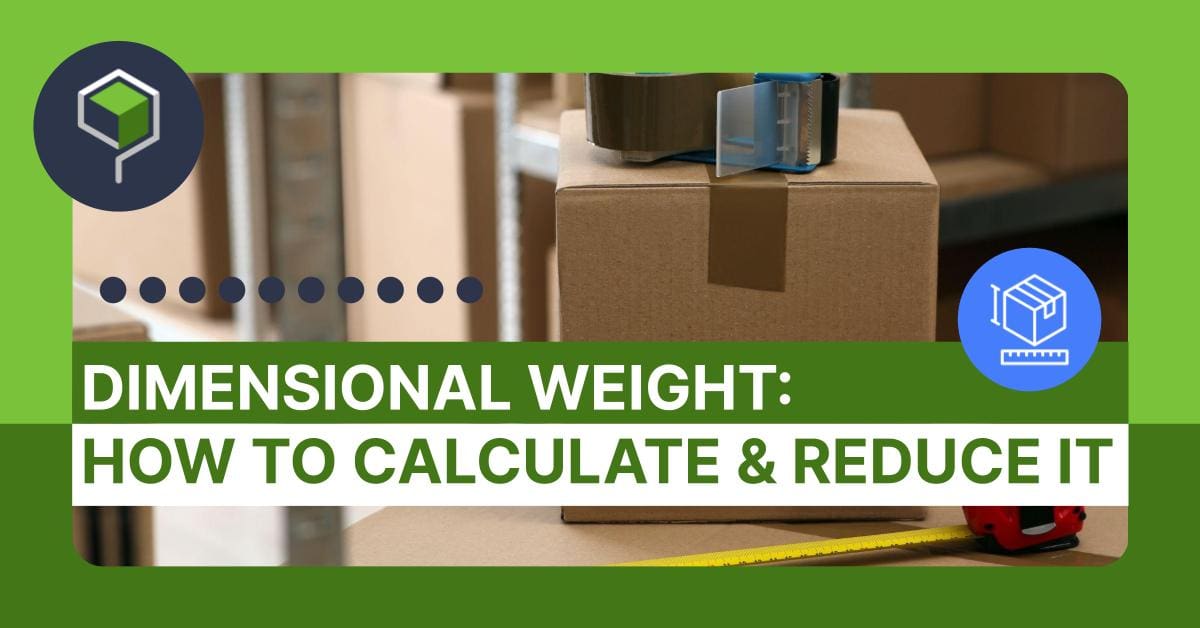Dimensional Weight: How to Calculate and Reduce it

Box size really does matter when you’re shipping online orders. The bigger the package, the more it will cost you to ship. While there are other factors at play when calculating shipping rates, like destination, service level, and handling requirements, size and weight has an outsized impact on on shipping costs.
Why? Because of the DIM weight pricing structure now used by almost all major carriers.
In this blog, we’re going to dive into dimensional weight pricing and what your business needs to know to calculate dimensional weight accurately – and how to reduce dimensional weight for more cost-effective shipping.
What is DIM Weight pricing?
DIM weight pricing stands for dimensional weight pricing, and refers to the primary way that both domestic and international shipping carriers charge for the shipment of packages. Unlike actual weight, dimensional weight takes into account both the weight and the dimensions of a package when calculating shipping costs. The billable weight of the package is based on either the package dimensions or the volumetric dimensional weight applied whichever is greater.
For example, if you are using a large box to ship a lightweight item, the size of the box is going to determine the billable weight being shipped, rather than the weight of the contents. This is why it’s important to use the right packaging for the size of the item, or the shipping rate will be substantially higher than necessary.
Why is dimensional weight used to calculate shipping rates?
Dimensional weight has gradually replaced actual package weight at most shipping carriers as a pricing metric. This is because the latter doesn’t take into account the amount of space a package takes up in transit. In practice, a very large, lightweight package can take up more space than a smaller heavier shipment, meaning fewer packages can be transported on that particular delivery round.
Because small parcel volumes have surged due to to the growing popularity of ecommerce, charging for shipping based on space taken up is a more accurate representation of value, rather than physical weight. DIM weight pricing means that shipping carriers to recover cost associated with transporting lightweight packages, which otherwise may be undercharged.
Furthermore, charging by dimensional weight gives shippers a major incentive to streamline package size in a bid to reduce shipping costs. By using smaller boxes or mailer envelopes to reduce package dimensions, businesses can save money on each shipment and reinvest these savings elsewhere. In turn, this frees up more space for the shipping carrier on delivery trucks or aircraft and improves the operational efficiency of major freight carriers.
How to calculate dimensional weight
DIM weight is calculated by multiplying package length, width, and height and dividing it by the ‘dimensional factor’ used by the shipping carrier. The DIM factor or dimensional weight divisor represents the amount of space that a package occupies in relation to its weight.
Major carriers will use a different DIM factor that takes into account their unique policies or standards concerning shipments and the size of their delivery trucks or aircraft. Because of this, each will host dimensional weight calculators on their website that give the details of their specific calculation of DIM weight charges.
To calculate dimensional weight, the general formula is as follows:
DIM weight = (Length x Width x Height) / DIM factor
Let’s break this down step by step:
- Measure your package: Carefully measure the length, width, and height of the package from the longest point (check whether your carrier is using inches or centimeters). Your measurement should take into account any irregularities, such as bulges or warpes in the sides of the package. Make sure you round up each figure to the nearest whole number.
- Calculate package volume: Multiply length, width, and height together to obtain the total volume of the package in cubic inches or centimeters.
- Apply the DIM Factor: Next, divide the volume of your package by the carrier’s dimensional factor (DIM factor) to determine the DIM weight. Each carrier will have its DIM factor, so make you the one you are using is correct.
- Compare with Actual Weight: The shipping cost will be either the package’s actual weight and the DIM weight, whichever is the higher weight.
Let’s say that you’re a homewares company that is shipping a customer an order of pillows that weighs 7 pounds. The package dimensions of the box you want to ship is 24 inches long, 18 inches wide, and 12 inches high, and the carrier is using a DIM factor of 139. To calculate DIM weight, the DIM weight formula would be expressed as below:
24 x 18 x 12 = 5,184
5,184 / 139 = 37.32 pounds
This means that the DIM weight charged to ship this order would be 38 pounds (rounded up from 37.52). The actual weight of the package is only 7 pounds, but because of the bulky nature of the shipment, dimensional weight rules.
How to reduce dimensional weight for cheaper shipping
In the above example, it’s easy to see how dimensional weight can cause your shipping costs to spiral if you aren’t taking care to keep package size under control. After all, there’s a world of difference between shipping an order weighing 7 pounds versus one that’s charged at 38!
So, what can your business do to keep DIM weight low and benefit from smaller shipping charges?
Use streamlined packaging
High DIM weight, and therefore high DIM weight pricing, is linked to a package’s dimensions. So, if your business is using bulkier packaging than necessary for customer orders, this is going to hit you right where it hurts (your wallet).
Making sure that you are using as streamlined packaging as possible doesn’t just eliminate waste, but ensure that you are being charged a reasonable rate to ship, For example, using poly mailers rather than boxes to ship apparel immediately cuts your shipping costs by a wide margin, as they are much smaller and lighter than boxes and ensure a lower volumetric weight.
Splitting shipments where it’s more economical
Even when packaging is as streamlined as possible, dimensional weight pricing can still make multi-item orders quite expensive to ship as one package. Instead, consider splitting an order into more than shipment with a lower dimensional weight. Even though you are paying to ship an order more than once, this can still work out less than sending one large package that takes up more space on a delivery truck.
Compare dimensional weight pricing between carriers
Although most major shipping companies now use a DIM weight pricing structure, different carriers will use a slightly different approach based on their own shipping services and transportation logistics. Understanding the differences in pricing technique will assist your business in getting the best deal for both domestic shipments and international shipments.
For example, FedEx dimensional weight pricing uses a dimensional factor of 139 all shipments, while UPS dimensional weight calculations uses a DIM factor of 166 for cubic size of one foot or less, and 139 for packages larger than one cubic foot. Because UPS’ DIM factor is higher for smaller packages, the dimensional weight calculated will be lower – and so will the shipping cost.
In sum, mixing up your carrier selection in this way allows you to keep your shipping costs low by using the dimensional weight charges that favor each particular shipment.
Consider using flat-rate shipping
Flat-rate shipping methods can provide a useful way for shippers to get around DIM pricing by paying a standard fee to ship, so long as the order contents fit within the packaging supplied by the carrier. Because a flat-rate service is charged based on specific package dimensions, shippers don’t have to worry about measuring and weighing every package. However, flat-rate shipping doesn’t always take into account the distance a package is traveling, meaning it can work out more expensive for orders that are transiting one or two shipping zones.
Dimensional weight pricing can be tricky for ecommerce businesses to navigate, especially as order volumes increase and customer expect shipping to be affordable and fast. Understanding dimensional weight and how to calculate dimensional weight pricing makes it easier for your business to navigate postal services and not waste precious dollars on shipping. By following the tips above, you can keep DIM weight down and create a more efficient, streamline shipping strategy that keep your business competitive in the race for faster shipping.



